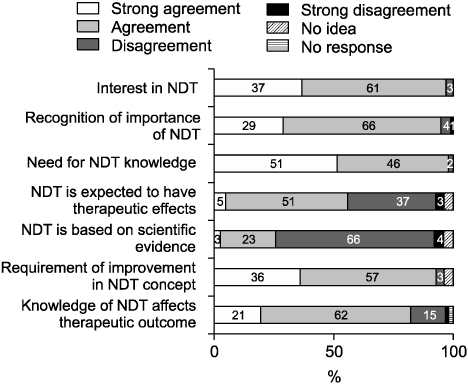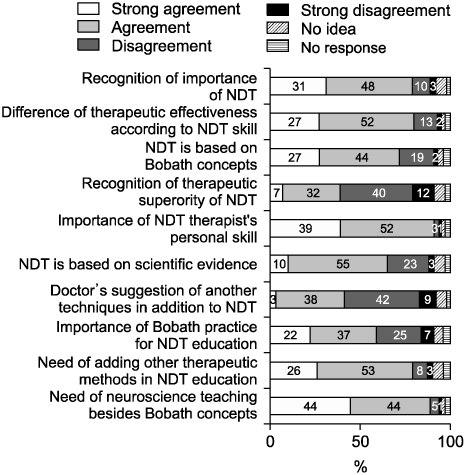Brain Neurorehabil.
2012 Sep;5(2):68-74. 10.12786/bn.2012.5.2.68.
Survey on Clinical Application of 'Neurodevelopmental Treatment'
- Affiliations
-
- 1Department of Rehabilitation Medicine, CHA University College of Medicine, Korea.
- 2Department of Rehabilitation Medicine, Inha University School of Medicine, Korea. rmjung@inha.ac.kr
- 3Department of Physical Medicine and Rehabilitation, Kyunghee University College of Medicine, Korea.
- 4Department of Rehabilitation Medicine, Konkuk University School of Medicine, Korea.
- 5Department of Rehabilitation Medicine, College of Medicine, The Catholic University of Korea, Korea.
- 6Department of Rehabilitation Medicine, Korea University College of Medicine, Korea.
- 7Department of Rehabilitation Medicine, National Rehabilitation Center, Korea.
- KMID: 2270743
- DOI: http://doi.org/10.12786/bn.2012.5.2.68
Abstract
OBJECTIVE
To investigate the recognition about clinical application of "neurodevelopmental treatment (NDT)". METHOD: We surveyed on the recognition for Bobath and NDT concepts and its training programs provided by Korean Academy of Rehabilitation Medicine from Jan 2009 to Feb 2009. The survey was made for physiatrists and physical therapists (PTs), separately. One hundred twelve physiatrists and 322 PTs have participated.
RESULTS
In physiatrist, interest in NDT was very high (98%), and the need for further knowledge of NDT was also high (95%). Though the NDT was mainly used techniques in neuro-rehabilitation setting, the expectation about effectiveness of it was moderate (56%) and the requirement of changing concepts of the NDT was very high (93%). PTs have carried out NDT most frequently with Bobath's concepts, but they also did not regard NDT as the best procedure. PTs emphasized the importance of their handling technique in NDT practices and also had high interest in the other maneuvers beside Bobath's.
CONCLUSION
Physiatrists and PTs regard NDT as one of the most important treating method for patients with brain lesions, but it is not approved as the most effective method yet. Nowadays NDT is changing or adapting, with discarding some of the old Bobath's concepts and adding new modern scientific knowledge. Therefore we suggest that physiatrists to give PTs the revised NDT concepts and evidence based the other therapeutic methods. And the NDT needs to be verified its therapeutic efficacy with evidence based view points through proper studies.
Figure
Reference
-
1. Keshner EA. Reevaluating the theoretical model underlying the neurodevelopmental theory. A literature review. Phys Ther. 1981. 61:1035–1040.2. Bobath B. The treatment of neuromuscular disorders by improving patterns of co-ordination. Physiotherapy. 1969. 55:18–22.3. Bobath K. The normal postural reflex mechanism and its deviation in children with cerebral palsy. Physiotherapy. 1971. 57:515–525.4. Lennon S, Ashburn A, Baxter D. Gait outcome following outpatient physiotherapy based on the Bobath concept in people post stroke. Disabil Rehabil. 2006. 28:873–881.5. Hafsteinsdottir TB, Algra A, Kappelle LJ, Grypdonck MH. Neurodevelopmental treatment after stroke: a comparative study. J Neurol Neurosurg Psychiatry. 2005. 76:788–792.6. Paci M. Physiotherapy based on the Bobath concept for adults with post-stroke hemiplegia: a review of effectiveness studies. J Rehabil Med. 2003. 35:2–7.7. Langhammer B, Stanghelle JK. Bobath or motor relearning programme? A comparison of two different approaches of physiotherapy in stroke rehabilitation: a randomized controlled study. Clin Rehabil. 2000. 14:361–369.8. Van Peppen RP, Kwakkel G, Wood-Dauphinee S, Hendriks HJ, Van der Wees PJ, Dekker J. The impact of physical therapy on functional outcomes after stroke: what's the evidence? Clin Rehabil. 2004. 18:833–862.9. Lennon S, Ashburn A. The Bobath concept in stroke rehabilitation: a focus group study of the experienced physiotherapists' perspective. Disabil Rehabil. 2000. 22:665–674.10. Lennon S, Baxter D, Ashburn A. Physiotherapy based on the Bobath concept in stroke rehabilitation: a survey within the UK. Disabil Rehabil. 2001. 23:254–262.11. Tyson SF, Connell LA, Busse ME, Lennon S. What is Bobath? A survey of UK stroke physiotherapists' perceptions of the content of the Bobath concept to treat postural control and mobility problems after stroke. Disabil Rehabil. 2009. 31:448–457.12. Raine S. The current theoretical assumptions of the Bobath concept as determined by the members of BBTA. Physiother Theory Pract. 2007. 23(1):137–152.13. Mayston M. Bobath Concept: Bobath@50: mid-life crisis--what of the future? Physiother Res Int. 2008. 13:131–136.14. Luke C, Dodd KJ, Brock K. Outcomes of the Bobath concept on upper limb recovery following stroke. Clin Rehabil. 2004. 18:888–898.15. Wagenaar RC, van Wieringen PC, Netelenbos JB, Meijer OG, Kuik DJ. The transfer of scanning training effects in visual inattention after stroke: five single-case studies. Disabil Rehabil. 1992. 14:51–60.16. Pollock A, Baer G, Pomeroy V, Langhorne P. Physiotherapy treatment approaches for the recovery of postural control and lower limb function following stroke. Cochrane Database Syst Rev. 2007. (1):CD001920.17. Kollen BJ, Lennon S, Lyons B, Wheatley-Smith L, Scheper M, Buurke JH, Halfens J, Geurts AC, Kwakkel G. The effectiveness of the Bobath concept in stroke rehabilitation: what is the evidence? Stroke. 2009. 40:e89–e97.18. Graham JV, Eustace C, Brock K, Swain E, Irwin-Carruthers S. The Bobath concept in contemporary clinical practice. Top Stroke Rehabil. 2009. 16:57–68.
- Full Text Links
- Actions
-
Cited
- CITED
-
- Close
- Share
- Similar articles
-
- Region Specific Brain Organoids to Study Neurodevelopmental Disorders
- Neurodevelopmental outcomes of preterm infants
- Clinical Application of Neurodevelopmental Assessment for Infants and Toddlers
- Psychological Assessment in Neurodevelopmental Disorders
- Probability of Transition to Psychosis and Bipolar Disorder in Individuals With Neurodevelopmental Disorders



